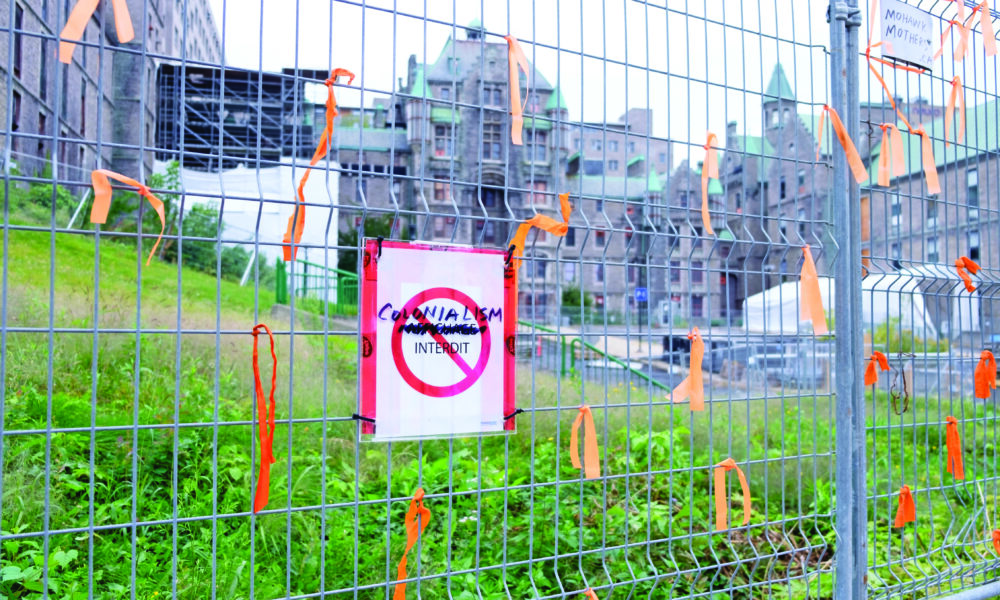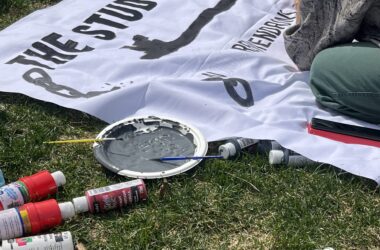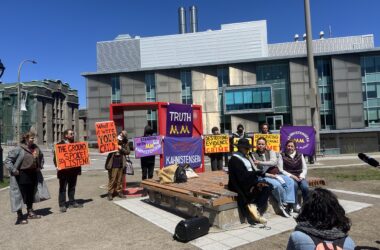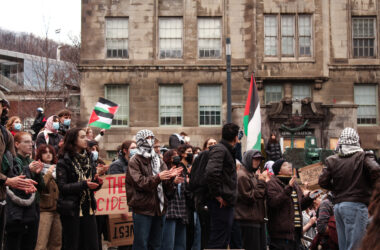Content Warning: Mentions of assault and death
The Kanien’kehá:ka Kahnistensera (Mohawk Mothers) called an emergency three-hour hearing on Sept. 14 over the ongoing archaeological investigation into McGill’s New Vic Project site, where they believe there may be unmarked graves of Indigenous children.
Prompted by McGill’s decision to commence drilling on the site on Sept. 12, the Mothers appeared before Justice Gregory Moore to request a Declaratory Relief and Safeguard Motion, which would effectively halt drilling and excavation on the site. Justice Moore ruled to not halt drilling on Sept. 18
As set out in the settlement agreement reached between the Mothers and the defendants—McGill, the Société québécoise des infrastructures (SQI), the Royal Victoria Hospital (RVH), the City of Montreal, and the Attorney General of Canada— in April, archaeologists have used Historical Human Remains Detection Dogs (HHRDD) and ground-penetrating radar (GPR) to search the former RVH grounds. On Aug. 3, McGill Provost and Vice Principal Christopher Manfredi announced that nine anomalies containing grave-type features were located. But the Mothers disputed this, alleging that McGill underreported findings on the site and omitted several more ambiguous anomalies.
McGill announced, to the Mother’s dissatisfaction, that the initial phase of the investigation had been completed in a Sept. 11 press release. On Sept. 12, McGill reported that the subsequent step of the investigation was beginning, which would involve infrastructural drilling and direct archaeological excavation in order to “render various buildings operationally autonomous.”
Drilling has started in Zone 10 of the site, in which no anomalies were found. However, Zone 10 borders on Zone 11, which contains potential anomalies. Since an anomaly is investigated by starting at the flagged spot and slowly excavating outward until it is found to be devoid of any grave-type features, the Mothers fear that drilling in Zone 10 could disturb the radius of Zone 11, in which evidence may lie.
On the day of the hearing, held at the Montreal Courthouse, Mohawk Mother Kwetiio was the first to speak. She asserted that McGill’s press releases, as well as Executive Director of the New Vic Project Pierre Major’s recent affidavit, inaccurately quoted a study that curtailed the reliability of HHRDD findings and did not acknowledge the advancements the technique has made in the twelve years since the study was released. While the study claimed that up to 70 per cent of HHRDD detections could potentially be false positives, Kwetiio shared that this number was exponentially reduced when more than one dog detected the same areas to be of concern.
Kwetiio also said that dismissing the HHRDD findings as an “absence of evidence” should be equated to denialism. She listed several other artifacts that should have been considered evidence but have not been further examined, including a woman’s dress and a ball of hair.
The Mothers claimed a breach of the settlement agreement had occured due to what they believe to be a lack of collaboration from the defendants, Kwetiio shared. Along with a refusal to share findings with the Canadian Archaeological Association (CAA) Working Group on Unmarked Graves for a peer review, Kwetiio alleged that the defendants did not accept many of the recommendations from the court-appointed archaeological panel, which disbanded on Aug. 3.
Kwetiio also insisted that Sections 2, 3, and 4 of the agreement—which grant the Mothers expedited access to the archives of McGill, McGill University Health Centre (MUHC), and Library and Archives Canada—have been breached, as the Mothers have not received access to the archives.
According to Kwetiio, the breaches of the agreement are setting a dangerous precedent for future relationships between Indigenous peoples and Canadian institutions. She ended her statement by calling McGill’s argument against halting work due to the financial burden of inflation “absurd” and asked Justice Moore to grant an urgent Declaratory Relief and Safeguard Motion.
“What happens there is when they excavate, where they put the piles, everything could be cross-contaminating,” Kwetiio said in a press conference after the hearing. “It’s important that certain places aren’t dug up, and that was our primary goal back in October [2022]: To stop the excavation before we find remains in the wrong manner.”
Next, Mohawk Mother Kahentinetha shared a statement before the court, explaining that on the New Vic site—where the Mothers are present daily alongside cultural monitors to oversee all excavation and ensure it is in accordance with Indigenous protocols—the Mohawk Mothers have been assigned dirty toilets to use in an area with flying debris. Additionally, Kahentinetha claimed that the security guard who verbally assaulted the Mothers and cultural monitors on July 25 had been present on the site once again.
McGill’s lawyer, Doug Mitchell, was the next to present to the court. He asserted that the mandate of the panel of archaeologists only went as far as Section 11 of the current settlement agreement, which states that the panel is limited to mapping and determining techniques. As dictated by Section 16, Mitchell explained that McGill and the SQI decide the executions of such techniques as soon as mapping is complete.
In an interview with The Tribune, Associate Provost Angela Campbell shared that work has been progressing in alignment with the panel’s mandate.
“The agreement that was reached among the parties recommended the establishment of a panel and the panel mapped the area of the site and mapped it according to different zones,” Campbell said. “Any work that’s been carried out on the site is being carried out in accordance with the techniques recommended by the panel.”
Since the panel has carried out Section 11, Mitchell told the court that the panel could reconvene if “there is some unexpected discovery,” at which point all parties would seek the guidance of the panel for next steps, as stipulated by the current settlement agreement.
When Justice Moore asked Mitchell what mapping constitutes, Mitchell explained it consists of creating an initial map of priority zones where anomalies could potentially exist. Kwetiio shared that since mapping is an ongoing process, however, and that the panel’s duties did not cease once they created the initial diagram.
Justice Moore also asked Mitchell about how the defendants can be sure that taking the soil out and putting it back into the ground in Zone 10 is an appropriate archaeological technique, as the panel has been disbanded and can not offer guidance. Mitchell stated that GeoScan—an archaeological firm specializing in GPR—is an expert firm and should be trusted with this task.
Finally, Julian Falconer—representing the third-party Office of the Special Interlocutor (OSI), Kimberly Murray—gave a statement. Falconer, who appeared before the court virtually, spoke to the immense distrust between parties—a distrust that has now fueled the perception that Murray is a biased party.
Falconer read aloud a passage from Murray’s June 2023 Interim Report, in which she states that her role is “not to be neutral or objective,” but rather “a fierce and fearless advocate to ensure that the bodies and Spirits of the missing children are treated with the care, respect, and dignity that they deserve.”
Falconer also frowned upon Mitchell’s earlier definition of the term mapping, which made disbanding of the panel permissible. He pointed out the panel’s numerous recommendations that were discarded by McGill and the SQI, indicating that the defendants seem to have a different definition of what “being bound by the panel” means in comparison to the Mothers.
Justice Moore asked Falconer what the OSI’s position is regarding the contention around Zones 10 and 11. Falconer emphasized that the panel is the heart of the agreement and that it should be restored prior to any discussions about the zones.
Justice Moore adjourned court without a ruling, explaining that he would need a few days to make a decision.
In a press conference after the hearing, Kahentinetha expressed that the Mothers will keep fighting, despite the legal obstacles they may face.
“We’re going after our children, and there’s no way we can just stop because the other party says, […] ‘You didn’t do this, or you didn’t do that,’” Kahentinetha said. “The children are here [….] We will do everything we can to find them.”
SQI was not available for comment before the publication deadline.
A previous version of this article stated that Justice Moore had not reached a decision as of Sept. 18. In fact, on Sept. 18, Justice Moore ruled that he would not grant the Declaratory Relief and Safeguard Motion. The Tribune regrets this error.








